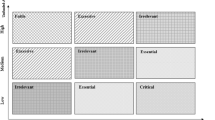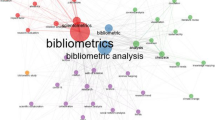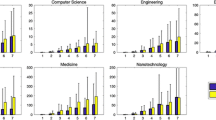Abstract
The goal of the study here is to model and analyze the relation between research funding and citation-based performance in science to predict the diffusion of new scientific results in society. In fact, an important problem in the field of scientometrics is to explain factors determining the growth of citations in documents that can increase the diffusion of scientific results and the impact of science on society. The study here confronts this problem by developing a scientometric analysis to clarify, whenever possible, the relation between research funding and citations of articles in critical disciplines. Data of 2015 retrieved from the Web of Science database relating to the three critical disciplines given by computer science, medicine and economics are analyzed. Results suggest that computer science journals published more funded than unfunded papers. Medicine journals published equally funded and unfunded documents, and finally economics journals published more unfunded than funded papers. In addition, funded documents received more citations than unfunded papers in all three disciplines under study. The study also finds that citations in funded, unfunded and total (funded + unfunded) papers follow a power-law distribution in different disciplines. Another novel finding is that for all disciplines under study, the Matthew effect is greater for funded articles compared to unfunded documents. The results here can support best practices of research policy directed to fund vital scientific research for increasing the diffusion of science and scientific findings in society.

Similar content being viewed by others
References
Alstott, J., Bullmore, E., & Plenz, D. (2014). Powerlaw: A Python package for analysis of heavy-tailed distributions. PLoS ONE, 9(1), e85777. https://doi.org/10.1371/journal.pone.0085777
Barabási, A. L., & Albert, R. (1999). Emergence of scaling in random networks. Science, 286(5439), 509–512.
Clauset, A., Shalizi, C. R., & Newman, M. E. J. (2009). Power-law distributions in empirical data. SIAM Review, 51(4), 661–703.
Coccia, M. (2005a). A Scientometric model for the assessment of scientific research performance within public institutes. Scientometrics, 65(3), 307–321. https://doi.org/10.1007/s11192-005-0276-1
Coccia, M. (2005b). A taxonomy of public research bodies: A systemic approach. Prometheus, 23(1), 63–82. https://doi.org/10.1080/0810902042000331322
Coccia, M. (2018). General properties of the evolution of research fields: A scientometric study of human microbiome, evolutionary robotics and astrobiology. Scientometrics, 117(2), 1265–1283. https://doi.org/10.1007/s11192-018-2902-8
Coccia, M. (2019). Why do nations produce science advances and new technology? Technology in society, 59, 101124. https://doi.org/10.1016/j.techsoc.2019.03.007
Coccia, M. (2020). The evolution of scientific disciplines in applied sciences: Dynamics and empirical properties of experimental physics. Scientometrics, 124, 451–487. https://doi.org/10.1007/s11192-020-03464-y
Coccia, M., & Bozeman, B. (2016). Allometric models to measure and analyze the evolution of international research collaboration. Scientometrics, 108(3), 1065–1084. https://doi.org/10.1007/s11192-016-2027-x
Coccia, M., & Wang, L. (2016). Evolution and convergence of the patterns of international scientific collaboration. Proceedings of the National Academy of Sciences of the United States of America, 113(8), 2057–2061. https://doi.org/10.1073/pnas.1510820113
Coccia, M., Falavigna, G., & Manello, A. (2015). The impact of hybrid public and market-oriented financing mechanisms on scientific portfolio and performances of public research labs: A scientometric analysis. Scientometrics, 102(1), 151–168. https://doi.org/10.1007/s11192-014-1427-z
Cronin, B., & Shaw, D. (1999). Citation, funding acknowledgment and author nationality relationships in four information science journals. Journal of Documentation, 55(4), 402–408.
de Solla Price, D. J. (1976). A general theory of bibliometric and other cumulative advantage processes. Journal of the American Society for Information Science, 27, 292–306.
Fortunato, S., Bergstrom, C. T., Börner, K., Evans, J. A., Helbing, D., Milojević, S., et al. (2018). Science of science. Science. https://doi.org/10.1126/science.aao0185
Gao, J. P., Su, C., Wang, H. Y., Zhai, L. H., & Pan, Y. T. (2019). Research fund evaluation based on academic publication output analysis: The case of Chinese research fund evaluation. Scientometrics, 119(2), 959–972.
Gillespie, C. S. (2015). Fitting heavy tailed distributions: The poweRlawpackage. Journal of Statistical Software, 64, 1–16.
Gök, A., Rigby, J., & Shapira, P. (2016). The impact of research funding on scientific outputs: Evidence from six smaller European countries. Journal of the Association for Information Science and Technology, 67(3), 715–730. https://doi.org/10.1002/asi.23406
Hicks, D., & Katz, J. S. (2011). Equity and excellence in research funding. Minerva, 49(2), 137–151.
Huang, Z., Chen, H., Li, X., & Roco, M. C. (2006). Connecting NSF funding to patent innovation in nanotechnology (2001–2004). Journal of Nanoparticle Research, 8(6), 859–879.
Jacob, B. A., & Lefgren, L. (2011). The impact of research grant funding on scientific productivity. Journal of Public Economics, 95(9–10), 1168–1177.
Katz, J. S. (2000). Scale-independent indicators and research evaluation. Science and Public Policy, 27(1), 23–36.
Katz, J. S. (2005). Scale-independent bibliometric indicators. Measurement: Interdisciplinary Research and Perspectives., 3(1), 24–28. https://doi.org/10.1207/s15366359mea0301_3
Katz, J. S. (2016). What is a complex innovation system? PLoS ONE, 11(6), e0156150.
Leguendre, P., & Leguendre, L. (2012). Numerical ecology (3rd ed.). Elsevier B. V.
Lewison, G., & Dawson, G. (1998). The effect of funding on the outputs of biomedical research. Scientometrics, 41, 17–27. https://doi.org/10.1007/BF02457963
Lotka, A. J. (1926). The frequency distribution of scientific productivity. Journal of the Academy of Sciences, 16(1), 317–323.
Merton, R. K. (1988). The Matthew effect in science, II: Cumulative advantage and the symbolism of intellectual property. Isis, 79(4), 606–623.
Morillo, F. (2020). Is open access publication useful for all research fields? Presence of funding, collaboration and impact. Scientometrics, 125, 689–716. https://doi.org/10.1007/s11192-020-03652-w
Pao, M. L. (1991). On the relationship of funding and research publications. Scientometrics, 20, 257–281. https://doi.org/10.1007/BF02018158
Quinlan, K. M., Kane, M., & Trochim, W. M. K. (2008). Evaluation of large research initiatives: Outcomes, challenges, and methodological considerations. New Directions for Evaluation, 118, 61–72. https://doi.org/10.1002/ev.261
Rigby, J. (2013). Looking for the impact of peer review: Does count of funding acknowledgements really predict research impact? Scientometrics, 94(1), 57–73.
Ronda-Pupo, G. A. (2017). The citation-based impact of complex innovation systems scales with the size of the system. Scientometrics, 112(1), 141–151.
Ronda-Pupo, G. A., & Katz, J. S. (2016a). The scaling relationship between citation-based performance and coauthorship patterns in natural sciences. Journal of the Association for Information Science and Technology, 68(5), 1257–1265.
Ronda-Pupo, G. A., & Katz, J. S. (2016b). The power–law relationship between citation-based performance and collaboration in articles in management journals: A scale-independent approach. Journal of the Association for Information Science and Technology, 67(10), 2565–2572.
Ronda-Pupo, G. A., & Katz, J. S. (2018). The power law relationship between citation impact and multi-authorship patterns in articles in Information Science & Library Science journals. Scientometrics, 114(3), 919–932.
Rousseau, R (2000, September). Are multi-authored articles cited more than single-authored ones? Are collaborations with authors from other countries more cited than collaborations whitin the country? A case study. In Proceedings of the second Berlin workshop on scientometrcs and informetrics. Collaboration in Sceince and Technology. Gesellschaft furr Wissenschaftsforschung: Berlin (pp.173-176)
Shen, C.-C., Hu, Y.-H., Lin, W.-C., Tsai, C.-F., & Ke, S.-W. (2016). Research impact of general and funded papers. Online Information Review, 40(4), 472–480. https://doi.org/10.1108/OIR-08-2015-0249
Su, A. I., & Hogenesch, J. B. (2007). Power-law-like distributions in biomedical publications and research funding. Genome Biology, 8(4), 404. https://doi.org/10.1186/gb-2007-8-4-404
Van Raan, A. (1998). The influence of international collaboration on the impact of research results: Some simple mathematical considerations concerning the role of self-citations. Scientometrics, 42(3), 423–428.
Van Raan, A. F. J. (2006). Statistical properties of bibliometric indicators: Research group indicator distributions and correlations. Journal of the American Society for Information Science and Technology, 57(3), 408–430. https://doi.org/10.1002/asi.20284
Van Raan, A. F. V. (2008). Bibliometric statistical properties of the 100 largest European research universities: Prevalent scaling rules in the science system. Journal of the American Society for Information Science and Technology, 59(3), 461–475.
Wang, J., & Shapira, P. (2011). Funding acknowledgement analysis: An enhanced tool to investigate research sponsorship impacts: The case of nanotechnology. Scientometrics, 87(3), 563–586.
Wang, J., & Shapira, P. (2015). Is there a relationship between research sponsorship and publication impact? An analysis of funding acknowledgments in nanotechnology papers. PloS ONE, 10(2), e0117727.
Web of Science. (2021). Web of Science, Search in: Web of Science Core Collection, http://apps.webofknowledge.com/WOS_GeneralSearch_input.do?product=WOS&SID=E5lSYgaLwJn6kp2iz2G&search_mode=GeneralSearch (Accessed 24 March 2021)
Yan, E., Wu, C., & Song, M. (2018). The funding factor: A cross-disciplinary examination of the association between research funding and citation impact. Scientometrics, 115(1), 369–384.
Ye, F. Y., & Rousseau, R. (2008). The power law model and total career h-index sequences. Journal of Informetrics, 2(4), 288–297. https://doi.org/10.1016/j.joi.2008.09.002
Zhao, S. X., Lou, W., Tan, A. M., & Yu, S. (2018). Do funded papers attract more usage? Scientometrics, 115(1), 153–168.
Acknowledgements
We would like to thank Professor J. Sylvan Katz for his helpful instruction on power-law analysis.
Author information
Authors and Affiliations
Corresponding author
Rights and permissions
About this article
Cite this article
Roshani, S., Bagherylooieh, MR., Mosleh, M. et al. What is the relationship between research funding and citation-based performance? A comparative analysis between critical disciplines. Scientometrics 126, 7859–7874 (2021). https://doi.org/10.1007/s11192-021-04077-9
Received:
Accepted:
Published:
Issue Date:
DOI: https://doi.org/10.1007/s11192-021-04077-9




